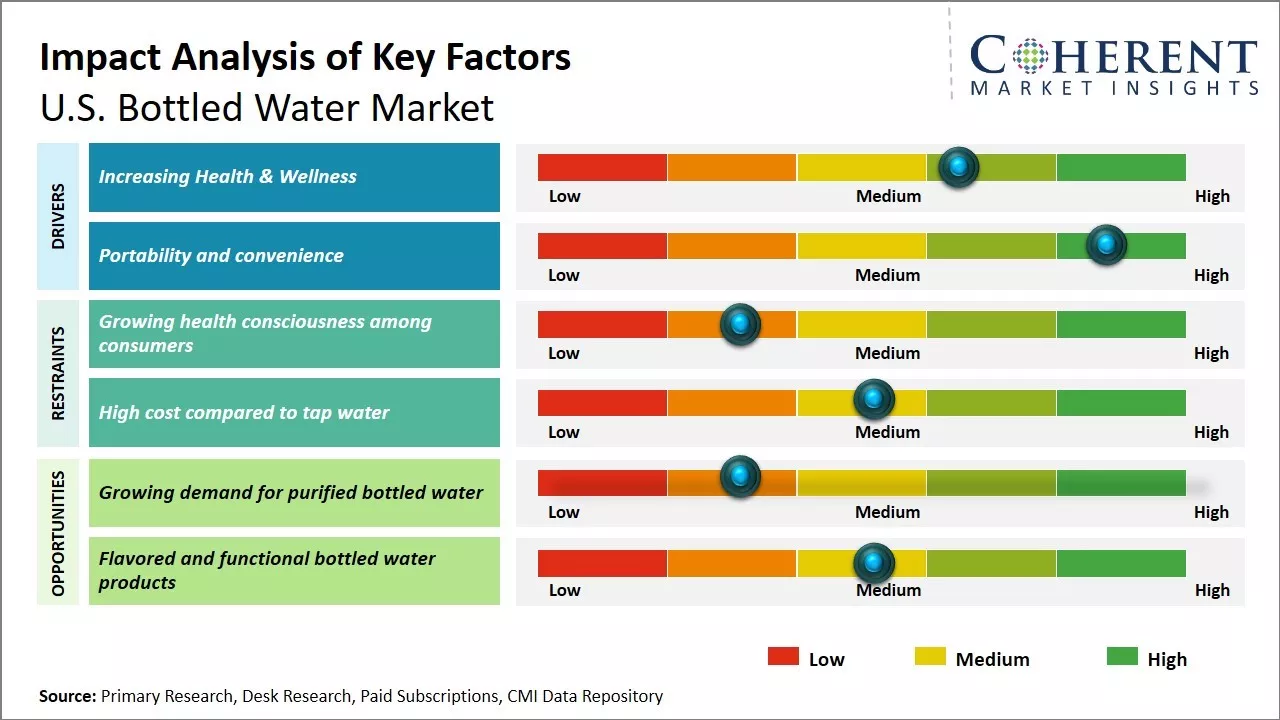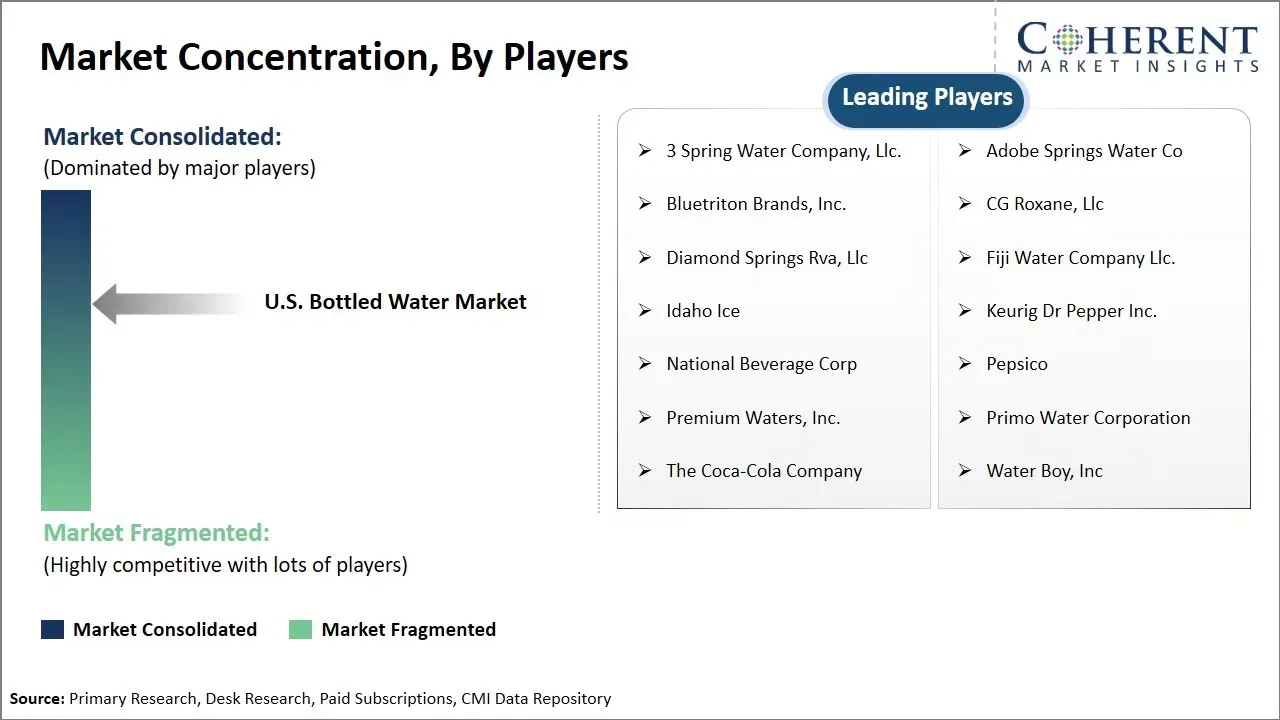The U.S. bottled water market is estimated to be valued at USD 30,695.6 Mn in 2025 and is expected to reach USD 54,722.3 Mn by 2032, exhibiting a compound annual growth rate (CAGR) of 8.6% from 2025 to 2032.

To learn more about this report, Download Free Sample
The U.S Bottled water market is witnessing steady growth due to growing demand for bottled water over soft drinks and sugary functional beverages owing to rising health and wellness concerns. Bottled water is considered as convenient and portable beverage option as compared to other types of water. Various marketing campaigns will lead to the strong brand loyalty among customers.
|
Current Events |
Description and its impact |
|
Merger of Primo Water and Blue Triton Brands to Form Primo Brands |
|
|
Viral Growth of Saratoga Spring Water as a Premium Brand |
|
Uncover macros and micros vetted on 75+ parameters: Get instant access to report
Consumer attitudes and demand patterns are central to dictating the U.S. bottled water industry. No less than 88% of Americans drink bottled water, with 87% having a favorable opinion about it as a drink option. This is underpinned by health awareness, as consumers increasingly choose bottled water over sweetened drinks like soda, which only 61% of Americans favor.
Demand is also driven by lifestyle. The American way of life has created a demand for easy, portable hydration products, and bottled water has become an everyday fixture. Its variety of package sizes and formats addresses a range of consumer demands, including single-serve bottles for quick on-the-go drinking and larger packages for use at home.
Taste and flavor are also critical in consideration. A whopping 29% of global consumers name taste and flavor as among the top reasons for their bottled water purchases. Flavoured water varieties, like lemon, lime, and peach, are on the rise, with 59% of bottled water trends including flavored variants. These developments appeal to consumers looking for diversity and richer flavor experiences.

To learn more about this report, Download Free Sample
Increasing health consciousness among Americans regarding the benefits of staying hydrated and importance of clean drinking water has been a key driver for the growth of bottled water market in the US. More and more people are recognizing that drinking enough water is essential for overall health and avoiding various lifestyle-driven diseases. As busy routines and dependence on packaged food leaves less time for proper hydration, bottled water has become a very convenient way for people to fulfil their daily water intake requirements while on the go.
Bottled water is perceived as a healthier alternative to carbonated drinks and high calorie beverages by health-conscious consumers. The changing dietary patterns and growing preference for low sugar options has contributed towards bottled water gaining popularity as a no-calorie refreshment.
Many bottled water brands prominently market their products as being free from additives and high in minerals to further appeal to the health-focused demographic. There is a perception that bottled water is safer to drink than tap water in certain regions due to potential contamination issues or unusual taste of tap water. Hence, bottled water provides assurance of clean, pure and great-tasting water anywhere, anytime.
Portability and convenience have made bottled water a ubiquitous feature of American life. With bottled water everywhere from grocery stores to convenience stores to vending machines, never has it been easier for Americans to hydrate while on the move. Active lifestyles have created a demand for an easily available beverage that can be snatched up quickly and taken in fast.
Bottled water is ideally suited for fast-moving lifestyles, as the consumer remains hydrated without needing to locate and transport refillable water bottles or search out drinking fountains. Such a high degree of convenience has allowed bottled water to become the nation's second most consumed beverage category after only carbonated soft drinks.
While public concern for the purity of tap water in certain areas persists, demand for purified bottled water is expected to continue. Functional and nutrient-fortified bottled water products are still in demand as a healthier alternative to other beverages. Established big bottled water companies can use their manufacturing and distribution capabilities in an effort to expand their national presence.
Still water segment by type is projected to hold the 71.7% market share in 2025. Americans perceive still water as the healthiest and purest choice, with most thinking that enhanced and flavored still water contains extra ingredients that is not needed.
The perception has remained unchanged even as competitors continue to introduce new product innovations. While splash or functional waters promote a particular health advantage, still water retains its charm of being a vaguely "healthy" drink without added ingredients or processing. In the meantime, decades of consistent use have embedded still water as a cultural tradition and household item.
It dominates grocery shelves, eateries, and home refrigerators in various regions and demographics. Habit and previous satisfaction secure further choice over tested substitutes. With the highest name recognition and consumer acquired habits, leading brands of still water are able to count on habitual repurchase from a mass base of loyal customers. Insights, By Packaging: Portability Drives PET segment.
With increasingly hectic lifestyles and less time for sitting down for a drink, carry-anywhere bottles that do not risk spilling have become a necessity. PET is the perfect answer to this need in its form of lightweight yet unbreakable build. From traveling to work, a workout in the park, or active family days out and about, PET bottles travel wherever they go without encumbrance. Their compressible stiffness keeps water cleanly contained even when carelessly thrown loose into bags.
With limited time for errands and hectic life schedules leaving limited space for heavy or fragile drink containers, PET's light-as-air handiness has made it ubiquitous among stay-hydrated-on-the-go Americans. PET packaging elevates branding visibility wherever bottled water goes. Vibrant labels remain prominently outward facing no matter the bottle's orientation, catching eyes during frequent advertisements.
Major water brands maximize versatile displays through optimally portable PET containers. Between enabling active daily routines and dynamic product visibility, PET has developed an unmatched symbiosis with the active American lifestyle that few competing forms can challenge. Its light, shatterproof construction will likely dominate the bottled water market for years to come based on proven performance on the frontlines of busy modern living.
Still water segment by type is projected to hold the 71.7% market share in 2025. Americans perceive still water as the healthiest and purest choice, with most thinking that enhanced and flavored still water contains extra ingredients they don't need.
The perception has remained unchanged even as competitors continue to introduce new product innovations. While splash or functional waters promote a particular health advantage, still water retains its charm of being a vaguely "healthy" drink without added ingredients or processing. In the meantime, decades of consistent use have embedded still water as a cultural tradition and household item.
It dominates grocery shelves, eateries, and home refrigerators in various regions and demographics. Habit and previous satisfaction secure further choice over tested substitutes. With the highest name recognition and consumer acquired habits, leading brands of still water are able to count on habitual repurchase from a mass base of loyal customers. Insights, By Packaging: Portability Drives PET segment.
Among distribution channel, off-trade segment is estimated to contribute 61.9% market share in 2025, leveraging mass merchandisers. Supermarkets and big-box stores drive the majority of packaged water volume in the United States through favorable scale and consciousness. As weekly routine shopping centers, supermarkets bring beverage assortment under a single large roof. Families depend on their wide selections for regular needs such as bottled water. Members equate the channel with family-size variety packs that are appropriate for parties or offices.
Mass club consumers form repeats habits replenishing large inventories. In contrast, on-trade distribution channels such as vending machines find themselves overshadowed by supermarket chains. As off-premise retail dictates family routines and brand exposures, the majority of consumers prefer tried-and-tested choices from main shopping arteries. Off-trade's convenience and visibility strengthen its dominance of bottled water distribution in the U.S. market.
| Report Coverage | Details | ||
|---|---|---|---|
| Base Year: | 2024 | Market Size in 2025: | USD 30,695.6 Mn |
| Historical Data for: | 2020 To 2024 | Forecast Period: | 2025 To 2032 |
| Forecast Period 2025 to 2032 CAGR: | 8.6% | 2032 Value Projection: | USD 54,722.3 Mn |
| Segments covered: |
|
||
| Companies covered: |
3 Spring Water Company, Llc., Adobe Springs Water Co, Bluetriton Brands, Inc., CG Roxane, Llc, Diamond Springs Rva, Llc, Fiji Water Company Llc., Idaho Ice, Keurig Dr Pepper Inc., National Beverage Corp, Pepsico, Premium Waters, Inc., Primo Water Corporation, The Coca-Cola Company, Water Boy, Inc |
||
| Growth Drivers: |
|
||
| Restraints & Challenges: |
|
||
Uncover macros and micros vetted on 75+ parameters: Get instant access to report
*Definition: U.S. Bottled Water Market consists of companies involved in the manufacturing, marketing, and distribution of bottled water for sale in the U.S. Major products in this market include spring water, purified water, sparkling water, and flavored water sold in plastic bottles ranging from singleserve sizes to larger gallons bottles. Bottled water competes with tap water but is seen as a healthier, more portable option. The bottled water industry has experienced significant growth over the past few decades
Share
Share
About Author
Sakshi Suryawanshi is a Research Consultant with 6 years of extensive experience in market research and consulting. She is proficient in market estimation, competitive analysis, and patent analysis. Sakshi excels in identifying market trends and evaluating competitive landscapes to provide actionable insights that drive strategic decision-making. Her expertise helps businesses navigate complex market dynamics and achieve their objectives effectively.
Missing comfort of reading report in your local language? Find your preferred language :
Transform your Strategy with Exclusive Trending Reports :
Frequently Asked Questions
Joining thousands of companies around the world committed to making the Excellent Business Solutions.
View All Our Clients